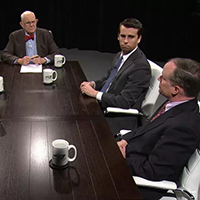Link between charter schools and segregation is faulty
Published May 2, 2015
by Bob Luebke, Civitas Institute, April 29, 2015.
Charter schools increase segregation – that’s the flawed conclusion of a recent National Bureau of Economic Research report by three Duke University Professors: Helen Ladd, Charles Clotfelter and John Holbein.
The report examines the evolution of charter schools in North Carolina between 1999 and 2012 “through the lens of a market model.” The authors determined that “[c]harter schools in North Carolina are increasingly serving the interests of relatively able white students in racially imbalanced schools.”
Major news outlets, including the Washington Post, have publicized the study. What hasn’t been mentioned are the study’s major weaknesses, which, when taken together, cast a doubt on the validity of its conclusions.
The authors say charter school growth is inextricably linked to development of a strong market impulse. Open markets where parents and providers can respond to changing conditions are an important factor in charter school growth.
Despite the author’s assertions, the claim of a strong market doesn’t really square with reality. Up until 2010, North Carolina capped the number of charter schools at 100. By all accounts, 100 was an artificial number, chosen simply because it allowed for each county in North Carolina to have one charter school.
How is a market model an effective tool for analysis when the entity that approves charter schools is a governmental body with its own interests at stake? The State Board of Education (SBE), which controls the approval, location and number of charters, sees them as competitors, and acts accordingly. The market model isn’t an effective tool for analysis when such a body runs the show.
The market model has other problems. The playing field for charter and public schools is supposed to be level. But is it, when NC charter schools must on average use 30 percent of their operating budget for facility costs? Is the playing field level when public schools shift around finances to limit the local average daily membership (ADM) funding they are required to share with local charter schools? These are realities that choke markets and keep them from flourishing.
It’s true current law allows eligible charter schools to expand enrollment by up to 20 percent without state approval. But it’s also true that one body outside the market – the State Board of Education –controls the number and type of schools that will be built.
The authors analyze data from 1999 to 2012. However, for 11 of the 13 years, a cap limited the number of charter schools that could be built. Only during two years (2011, 2012) is there no cap on the supply of charter schools. Is it accurate to say during this time period charter school growth has been propelled by market forces?
The authors claim that the introduction of charters and a market model of education has resulted in winners and losers, to the detriment of students and our communities. The Duke professors contend, “Many white parents are using charter schools, at least in part, to avoid more racially diverse traditional public schools.” That’s a big claim – with no real evidence. Still the authors don’t walk back from it. The authors refer to the early history between vouchers and segregation in North Carolina and apparently are willing to extrapolate those sentiments – without evidence – far into the future. It’s a dangerous claim.
Ladd, Clotfelter and Holbein assert that the racial composition of charter schools is much different than that found in traditional schools. The authors claim that the composition of charter schools has historically been racially imbalanced, with schools either being predominantly white (less than 20 percent nonwhite) or predominantly minority (more than 80 percent nonwhite). They also assert that the share of minority students in charter schools has declined. These results are much different than racial composition found in traditional public schools and far less diverse than in traditional public schools.
To substantiate racial imbalance claims the authors compare charter schools and traditional student populations for race for 1998 and 2014. However, it’s wrong to compare charter school enrollment to the average enrollment, statewide. Public schools can vary significantly from community to community. Since charter schools are required to mirror the composition of their local communities, a more valid comparison would be to compare local charter school enrollment to their local traditional public school counterparts. While the authors did attempt to satisfy these concerns by controlling variables and making comparisons as close as possible, in my view they fell short.
Do such comparisons matter? Yes – significantly. That is because many charter school students already attend school in intensely segregated settings.
In 2009, researchers at RAND focused on segregation in five major metropolitan areas: Chicago, Denver, Milwaukee, Philadelphia and San Diego. They followed students from traditional public schools to charter schools and found “surprisingly little effect on racial distributions across sites.” More specifically, “Across 21 comparisons (seven sites with three racial groups each—national, state and metro areas) we find only two cases in which the average difference between the sending traditional public school and the receiving charter school is greater than 10 percentage points in the concentration of the transferring student’s race.”
In my view, Ladd, Clotfelter and Holbein obscure the differences in school-level demographics among charter and traditional public schools. Such comparisons also ignore the fact that intentional placement of charter schools in urban, disadvantaged areas almost guarantees that their populations will be larger, more disadvantaged and likely more segregated than the population of statewide traditional public school averages.
However, let’s not get lost in the weeds. This is merely the framework on which the authors build their larger claim: White parents are using the charter schools at least in part to avoid the more racially diverse traditional public schools. It’s a bold statement that lacks real evidence (How do you measure motivation?) and is based on a questionable assumption.
Are the public schools more racially diverse? Of course, on a statewide aggregate basis the public schools are more diverse. But public schools are local entities that serve local – not statewide – communities. Public schools mirror the composition of local communities, which may frequently be dominated by one race and not reflect the composition of a statewide population.
Are charter schools merely a vehicle for segregation? The fact is, the percent of black students in public charter schools is actually higher than black enrollment in traditional public schools. According to the North Carolina Office of Charter schools 2015 Executive Report, black students comprised about 30 percent of charter school enrollment and 26 percent of traditional public school enrollment. Since the cap was lifted in 2011, black student population in charter schools has increased 20 percent while the percentage of white students in charter schools has increased 21 percent. Rapid segregation? Hardly.
It should be noted that charter schools are statutorily required to mirror the composition of the surrounding local communities. We also need to remember that the larger, more popular charters have waiting lists. As such they are required to admit students via a lottery. This raises an interesting point: How can schools reflect the surrounding community when admission is determined by ping-pong balls? That’s something to consider.
If charter schools are indeed vehicles that propel segregation among niche markets, wouldn’t students and parents be the first to come face-to-face with that message? Then what explains the high levels of support for charter schools and school choice among minorities? What explains the tremendous growth among charter schools and the long waiting lists? Charter schools are growing because they provide quality educational opportunities. Visit a charter school. More than likely you’ll find happy and engaged students, and satisfied parents.
Are charter schools perfect? Of course not. However, they work, because they meet a need and respond to a truth that the public schools often ignore: students learn differently. The important question is whether parents will continue to have the freedom to choose where to educate their children, or whether that option will be limited by what others perceive as more desirable social goals. Only time will tell.
http://www.nccivitas.org/2015/link-between-charter-schools-and-segregation-is-faulty/
May 2, 2015 at 11:38 am
Richard L Bunce says:
The government education industrial complex will never give up their near monopoly on education funding without a fight, a nasty fight if necessary. Parents having an education choice other than the traditional government school they have been assigned makes all the sense in the world but cannot be allowed under any circumstances by the defenders of the failed status quo. Ironic that many of their wealthy supporters including elected officials and government education bureaucracy members already send their children to alternative schools. What is good for the goose is definitely not good for the gander. This wealth divide is to be preserved at all costs by those who rail against such things in every other circumstance every day.
May 5, 2015 at 5:46 pm
Rip Arrowood says:
I noticed you didn't address the segregation issue - which was the topic of the column....
May 6, 2015 at 11:34 am
Richard L Bunce says:
Unless you are ready to tell families where they have to live and work and retire then families will either integrate or segregate on their own without any government intervention. Why is it the progressive do gooders always take their social scientist nonsense out on little kids? Why is it they fear low income parents having the same choices as their high income friends in government who send their children to segregated private schools? This is a ruse, a prevarication, a canard... and I cannot figure out if they know that or not.
May 7, 2015 at 11:55 am
Rip Arrowood says:
Where people live work and retire has no relevance in charter school segregation. Charters have no districts and can dismiss students from their schools while public schools are obligated by law to take everyone/ every race/ religion and socioeconomic background.
Why do charters have these options and public schools do not?
Why do charters fear that low income parents will have the same choices as their high income counterparts?
May 8, 2015 at 11:39 am
Richard L Bunce says:
So again to you segregation is only an issue for K-12 children? Adults bullying kids to do what they say not what they do? Classic government education industrial complex think.
Traditional government schools kick out students all the time. See the first three charts in the link... https://www.ncdps.gov/div/JJ/Policies/deptOfPublicInstructionPresentation2-11-10.ppt
I don't particularly care what government Charter schools think they are offering... I care what the parents think the school of their choice is offering their child in an education. You can bring up all the red herrings you want and you cannot escape that one essential point... parents have the responsibility to decide what is best for their child and should be provided the resources to make the best possible decision.
May 13, 2015 at 11:12 am
Curt Budd says:
You continue to make the argument "parental choice." But that's not the debate. Only the most callous would deny that in a perfect world, parent's would get to send their child to the "best" school possible. The issue is... is it MORALLY right to use public monies to support schools that DO discriminate and are not under the same ACCOUNTABILITY as public schools. If you believe that strongly in sending your child to a school that discriminates, then you should be willing to pay your own way.
Additionally, then those schools are compared to normal, public schools. If they can pick and choose their clientele, they should be way outperforming regular public schools, but the irony is, they don't. There are just as many low-performing charter schools. My school is one of the top public high-schools in the state, and the highest performing high-school, public, private, charter, or otherwise in the county. Could you imagine if we were allowed to just "dismiss" the lower third academic students in our school? We automatically become one of top performing schools in the country without doing anything different in our approach.
Finally, and I've tried to make this point before. Theory and practicality are two very different animals. If we are to be completely "parental choice". Then why cant a student from the other side of town attend MY PUBLIC school? Why not from a neighboring county? Because it would be impossible to put into practice with limited resources and fairness.
If the parent wants to use a voucher to attend a school that is open to all, has equal or more accountability than the normal, public school, then I could support it. But that is NOT the case, and therefore, is just ethically wrong.
May 16, 2015 at 10:50 am
Richard L Bunce says:
Parent choice is exactly THE debate and the government education industrial complex will do everything in their power to not debate on that ground because they know the parents interests and their interests do not align.
IF as you claim parents will not have a real choice other than traditional government schools then they will send their children to traditional government schools. Unlike traditional government schools the alternate schools do not get a dime of taxpayer funding UNTIL a parent decides to send their child to that school. I think it would be fantastic if the traditional government schools were funded the same way.
Just because traditional government school supporters continue to make the correct point that traditional government schools cannot handle the task they were given and that parents having a choice does not fix the problem in traditional government schools is NOT a problem with parents having a choice but of the systemic issues in all government programs and especially the traditional government schools.
Taxpayer dollars support many programs that subsidize citizens/residents economic activities with private for profit entities. The government education industrial complex spitting out another lost generation of students is what is unethical.
May 5, 2015 at 2:40 pm
Curt Budd says:
There are so many circular arguments in this article, where to begin? How about we focus on the main theme. "What is the evidence that white parents are using charter schools to avoid more racially diverse public schools?" The evidence is THEY ASKED THEM. And statistically reported it. Did the author read the report?
I don't understand why these advocates will not just admit that they would like to be able to attend a discriminating school that is still financed by public money. Quit trying to twist the argument with "educational freedom". If you want the "freedom" to attend a segregated school, just admit that. And lets debate whether that should be allowed. No different than wanting to get legal backing to discriminate under the guise of "religious freedom". If that is your belief system, fine, lets debate that, not whether or not you should have the "freedom" to do so. That's not freedom.
And who exactly are these "wealthy" benefactors of the status-quo educational system? Definitely not teachers! I have nothing to gain economically one way or the other, I just have a passion for what is morally RIGHT for the future of my 11yr old son and what is best for the future of the students I pour my heart and soul into every day.







